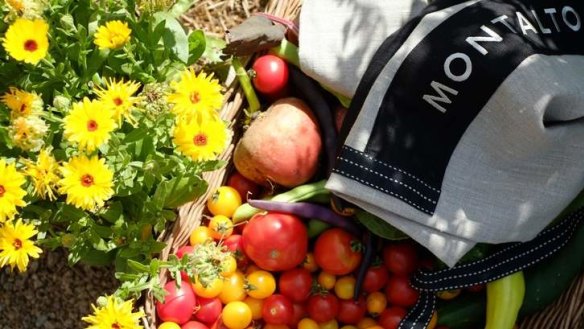Growing the business
The work can be demanding but a ready supply of rare fruit and vegetables brings many rewards.

In summer, sweetcorn and Jerusalem artichoke plants stretch skyward, heirloom stringless beans clamber over a trellis and heirloom tomatoes - black Russian, green zebra, tigerella, juan flamme - shine in hues of orange, red and green, and at the edge of Montalto's kitchen garden, double dazzler sunflowers honour their name.
One of Montalto's owners, Wendy Mitchell, is the green thumb behind the Mornington Peninsula winery-restaurant's 15 resplendent vegetable beds and fruit and nut tree orchard. Each season she works with chef Barry Davis to decide what to plant, their triumphs ending up on the plate.
Inside the greenhouse, Mitchell, 69, has sown delicate microherbs in punnets, which will be be used as edible garnishes, and spectacular red sorrel, which Davis wilts and serves alongside roasted duck breast with grape jus.
The focus of the garden is on heirloom and unusual varieties, edible flowers and herbs.
But the chef's favourite crop is quince, which he serves glazed with salted caramel ice-cream.
This year, Mitchell successfully experimented with elderberries, and also grows medlars, an ancient fruit that is not ripe until it's almost rotten, she says.
Staples, such as onions, potatoes and carrots, and popular menu items, such as artichokes, are sourced from local suppliers. ''To grow enough food to supply a busy restaurant you need acres of land and a team of gardeners,'' she says.
Having a garden on site means there is little food wastage, Davis says. They harvest only what they need and all scraps are composted back into the garden, the plants thriving with a dose of worm ''tea'' produced by the worm farm.
Close to the kitchen is an array of citrus trees - Tahitian and kaffir lime, meyer, lisbon and eureka lemons, oranges and mandarins. Beyond the grapevines and flourishing wetlands is an orchard that produces peaches, plums, apricots, cherries, persimmons, almonds, nectarines, figs, pears, plums, quinces and five kinds of apples.
But while having a restaurant kitchen garden at your doorstep sounds romantic, it's time-consuming and back-breaking work with no guarantee of success. ''Our tomatoes were late to ripen this year so we had to buy them from our local supplier.''
Shortly after, Davis was inundated with the home-grown crop, says Mitchell, who works in the garden seven days a week when necessary and has a full-time assistant. The challenge for the kitchen is coming up with ways to incorporate high yields into the menu and keeping up with preserving.
Pests, such as harlequin beetles, field mice, bush rats and water birds, are another challenge. The garden is organically grown and companion-planted. When necessary, Mitchell uses a natural insecticide made from pyrethrum, from the crysanthemum family.
Human pests can be a problem, too. Despite the orchard being netted and the gate locked, before Christmas last year Mitchell went to harvest cherries, only to find the nets torn and every ripe cherry picked from the four trees. The nets were repaired, only for the same thing to happen to the plum trees. ''The fruit is the reward for your work through the season,'' Mitchell says.
Wendy's gardening tips:
■ Maximise space by growing vertically - fences for espaliered fruit trees, frames or trellises for climbing peas, beans, etc.
■ Plant garlic chives as a perennial border. The attractive flat garlic flavoured leaves can be used in cooking and as companion plant help to repel pests.
■ Save seeds from favourite vegetables to share with friends or plant next season. Remember to label and date them.
■ Mulching keeps moisture in and weeds down.
■ Wendy recommends Judith Collins' book Companion Planting in Australia: Working with mother nature.
Autumn planting: parsley, coriander, broad beans, broccoli, brussels sprouts.
Tomato tart with goat's cheese
From chef Barry Davis, Montalto Vineyard and Olive Grove.
INGREDIENTS
1kg plump heirloom tomatoes
10 sprigs thyme
2 bay leaves
4 cloves garlic
80g sugar
80ml red wine vinegar
50ml olive oil
200g homemade or good quality store-bought butter puff pastry
250g goat's cheese (Barry likes Main Ridge)
salt and pepper
Rocket leaves, to serve
METHOD
Preheat oven to 130C.
Cut tomatoes in half and remove seeds. Place tomatoes in a bowl and toss with chopped thyme, bay leaves, sliced garlic, salt and pepper. Cover and place in fridge.
Heat the sugar in a pan over a medium flame until the sugar has dissolved and starts to turn golden caramel. Take the pan off the heat and pour in the vinegar, then return back to the heat stir until all combined.
Pour the caramel on to the halved tomatoes then place on baking tray and place in oven for 1 1/2 to 2 hours until they are cooked. They should still be holding their shape.
Pour the olive oil into a 25cm round baking dish and place tomatoes on the bottom, arranging them close together and discarding any thyme stalks or big pieces of garlic. Then set them aside to cool. This can be done up to a day ahead and left in the fridge.
Preheat oven to 200C. Cut or roll the puff pastry to a size that will cover the tomatoes and fit just inside the dish and place it over the tomatoes.
Bake in oven until the pastry has risen and turned golden brown, 15 to 20 minutes.
Let the tart cool for about five minutes then turn out on to a plate. Crumble over some goat's cheese and garnish with rocket.
Serves 4
Montalto Vineyard & Olive Grove, 33 Shoreham Road, Red Hill South; phone 03 5989 8412.
Restaurant reviews, news and the hottest openings served to your inbox.
Sign up